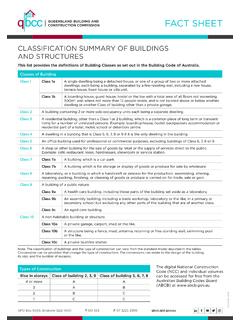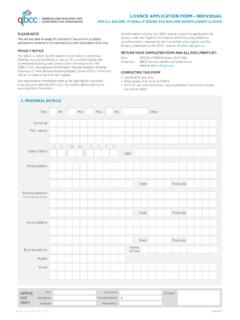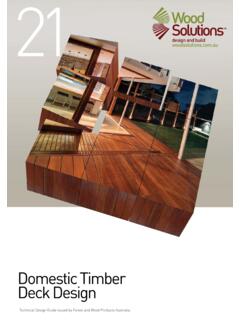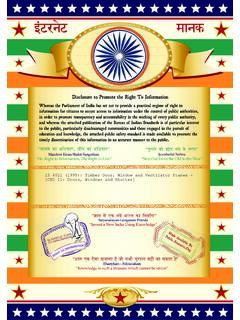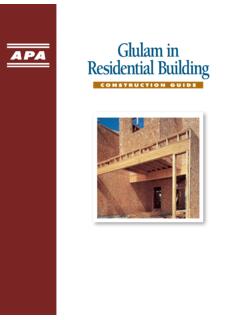Transcription of TECHNICAL DATA SHEET ISSUED BY TIMBER QUEENSLAND ...
1 TIMBER QUEENSLAND LIMITED TECHNICAL DATA SHEET 13 RESIDENTIAL TIMBER DECKS CLOSE TO OR ON THE GROUND Revised February 2014 Page 1 When designing and building TIMBER decks where TIMBER is less than 400 mm from or on the ground, considerations must be given to the following to ensure good long term performance: adequate ventilation surface drainage correct TIMBER species selection access for future maintenance and termite SELECTIONW here framing timbers are more than 150 mm above the ground TIMBER should be termite resistant, Above Ground Durability Class 1 or better (with sapwood H3 treated) blackbutt, spotted gum, ironbark, cypress, forest red gum, Gympie messmate, or H3 or better preservative treated lower decks or those on the ground, framing TIMBER should be In-ground Durability Class 1 (sapwood treated to H5) or H5 preservative treated boards should be Above Ground Durability Class 1 (sapwood treated to H3)
2 , or H3 preservative treated softwood. Commonly available TIMBER suitable for this purpose include - turpentine, spotted gum, ironbark, forest red gum, white mahogany, tallowwood, blackbutt, cypress, merbau (kwila), balau and preservative treated pine. These timbers are termite : CCA treated decking boards shall not be used in residential SIZESFor sizes of bearers, joists and allowable joist spacings, refer to Tables 1 - 3. Other grades and sizes can be used in accordance with AS1684 - Residential TIMBER Framed : Tongue and Groove flooring should not be used in weather exposed decks are built close to the ground, a considerable moisture gradient can occur through the thickness of decking boards which can result in cupping.
3 For this reason it is recommended that the maximum width of standard thickness (19 - 22 mm) decking be limited to 100 mm (nominal). For other decking, the width should not exceed 4 times its CONSTRUCTIONThe ground beneath the deck should be graded away from adjacent buildings and the deck so that water does not pond. In some cases agricultural drainage pipes may be needed to ensure water is removed from under the would also be good practice to lay down a plastic membrane under the deck, covered with gravel or sand to keep it in place. This will help keep soil moisture from affecting the TIMBER as well as preventing any vegetation MANAGEMENTOnly termite resistant timbers should be used for these decks.
4 However, protection of the dwelling to which the deck adjoins must also be considered. This could be achieved by leaving an appropriate gap for inspection (refer figure 2). It may be necessary to provide a removable panel, to inspect physical management systems ( metal caps) or to retreat where a chemical perimeter treatment to Australian Standard AS has been used on the BEFORE FIXINGFor maximum serviceability and protection against weathering, TIMBER decking should be properly finished and maintained. Before fixing, the following should be applied:(i) For Oil Based Stain Finishes(a) Give all faces and edges of decking and top edge of deck joists one coat of water repellant preservative such as:* 10% copper naphthenate in a light organic solvent.
5 * 20% zinc naphthenate in a light organic solvent and,(b) The first coat of stain should be applied all round to decking and to top edge of deck joists before : Some stains may not be compatible with water repellant preservatives. Seek stain manufacturer s advice before applying PRACTICE // FEBRUARY 2014 RESIDENTIAL TIMBER DECKS CLOSE TO OR ON THE GROUNDTECHNICAL DATA SHEETISSUED BY TIMBER QUEENSLAND13 TIMBER QUEENSLAND LIMITED TECHNICAL DATA SHEET 13 RESIDENTIAL TIMBER DECKS CLOSE TO OR ON THE GROUND Revised February 2014 Page 2(ii) For Acrylic Stains and Paint FinishesAll faces and edges of decking and top edge of deck joists should be primed with a good quality wood primer, followed by one coat of the selected decking paint (as per the manufacturer s specifications).
6 Note: Pale colours are best, dark colours can accelerate degrade and decay.(iii) End SealingAll cut ends should be sealed with preservative, stain or primer, depending on the final coating, prior to being fixed in number of methods are suitable depending on the design. For very low decks, bearer less construction could be used. joists are supported on a nailing plate on concrete beam walls (refer Figure 1). This method is acceptable as long as the concrete does not inhibit drainage. Likewise, TIMBER bearers could be laid directly on a well drained gravel/sand or concrete base as long as they are of minimum in-ground Durability Class 1 or H5 treated softwood, and again do not inhibit the drainage of water.
7 A panelised decking system could be used to allow for easy maintenance and to the proximity to the ground, ventilation is very important. For this reason, the perimeter of the deck should be kept decking, a minimum spacing between boards of 5 mm is bolts , screws, nails, brackets, framing anchors and other hardware should be hot dipped galvanised or stainless steel. Electroplated fasteners are not suitable due to early breakdown of the plating. For recommended minimum nail size for fixing the decking refer to Table 1. Each board (over 68 mm wide) should be fixed at every joist crossing with two nails. Nails should be located at least 12 mm from board edges.
8 The ends of boards should be predrilled prior to nailing to avoid splitting. Adjacent nails should be driven at slightly opposing angles. When bullet head nails are used with hardwood or cypress decking, they should be driven flush with the surface. Do not punch and Note: Fixings within 1 metre of pool surround should be stainless steel or monel AFTER INSTALLATIONT imber serviceability is enhanced by the application of a suitable finish, whether the surface be sawn or dressed. The finish may take the form of a clear external decking finish, a pigmented oil based stain, or a good quality paint system. The use of the finish should be in accordance with the finish manufacturer s recommendations.
9 The retention of the TIMBER s original colour cannot be guaranteed with the use of a clear long term performance of TIMBER decking in weather exposed situations is dependant on regular and effective maintenance. The frequency of maintenance will depend on the type of finish and the degree of exposure to the recoating, the decking should be thoroughly cleaned and the gaps between boards, particularly over joists, cleared of debris. Recoating should be carried out in accordance with the finish manufacturer s over-watering of pot plants standing on TIMBER decks should be avoided. It is recommended that pots be placed in drip trays standing on small cleats.
10 Where possible decks should be broom/blower cleaned rather than cleaned by 1 - DECKINGS pecies Min. GradeThickness (mm)Max. Joist Spacing (mm)Nailing Requirements (see Note #)HardwoodStandard Grade (AS 2796)1950050 x Galv Bullet Head2565065 x Galv Bullet HeadF17 (AS 2082)3280065 x Galv Bullet HeadCypress*Standard Grade (AS 1810)2145050 x Galv Flat HeadF5 (AS 2858)3470065 x Galv Bullet HeadTreated Pine (H3)Standard Grade (AS 1782)2245050 x Galv Flat HeadF7 (AS 2858)3575065 x Galv Flat Head or 75 mm Batten Screw4595075 x Galv Flat Head or 75 mm Batten ScrewNotes: * Cypress containing sapwood should not be used closer than 250 mm from ground. Refer recommendations in AS 1810.



